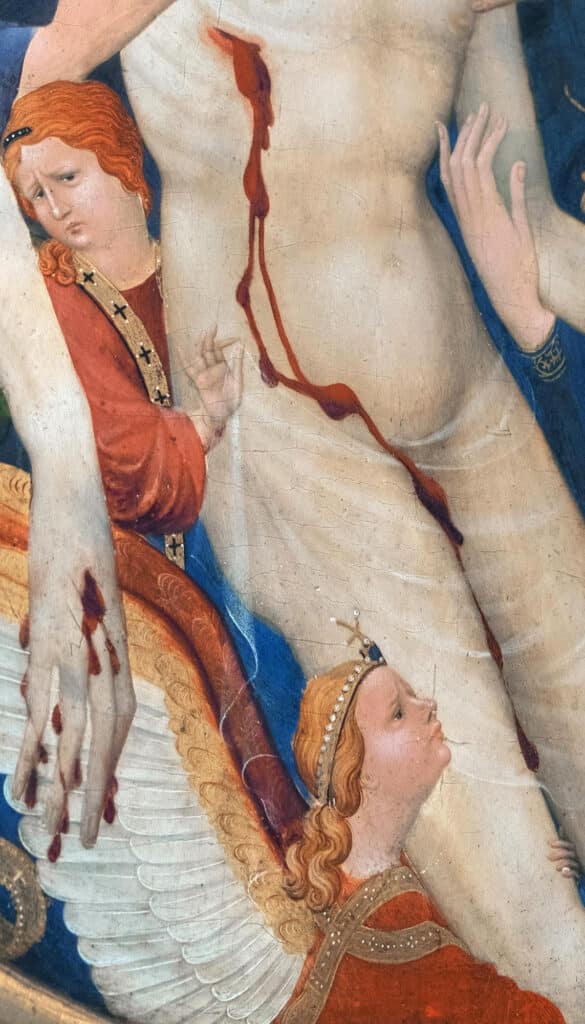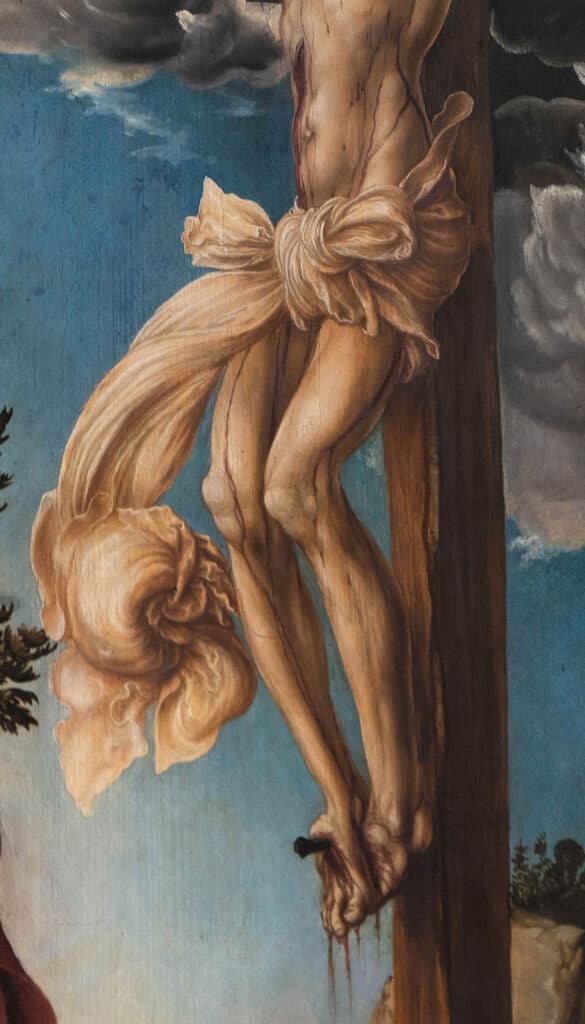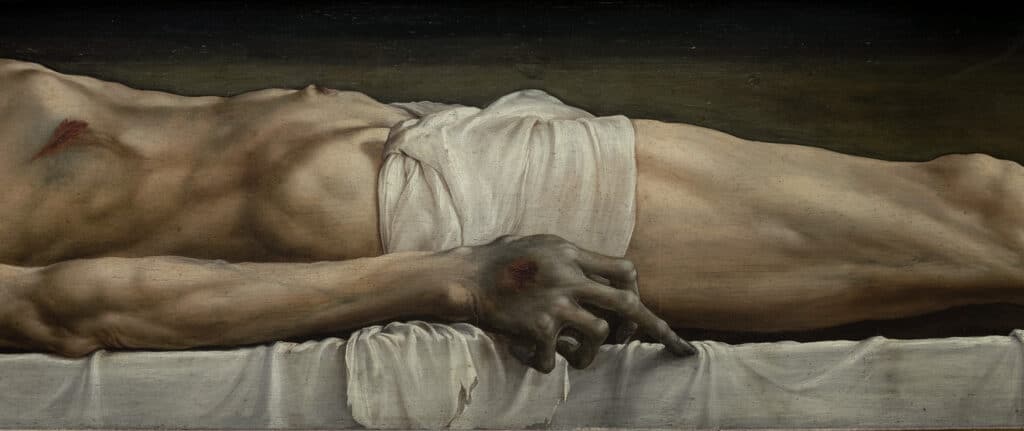
Never before has a project like this been carried out on a detail such as the perizonium. The loincloth covering Christ’s nakedness is a central element in the scenes of the Passion and the descent from the Cross. Sometimes it falls to his knees, sometimes billows in the breeze, sometimes the cloth is diaphanous… And yet the veil of modesty has inexplicably remained a blind spot in the history of art.
The French photographer Jacqueline Salmon has produced a fascinating body of work. She spent 5 years traveling around Europe and its museums to capture this fragment in great works of art. She brings together over a 1000 years of art history in an exhibition that reveals the symbolic force of a single detail across the ages.
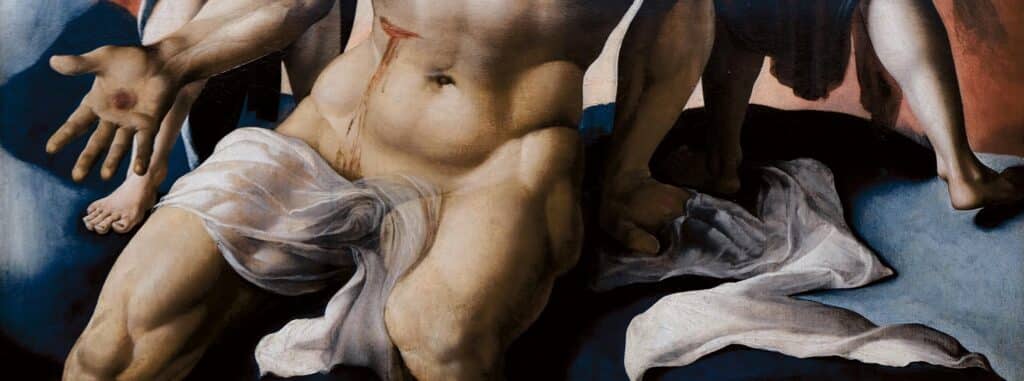
Showcased at the Musée Réattu as part of the Rencontres d’Arles, the exhibition “Blind Spot. Perizonia: A Study and Variations” stages a dialogue on the mount where Michelangelo converses with Giotto, Rembrandt sits next to Grunewald… Salmon’s photographic approach draws its clarity from her extremely precise and thoughtful choice of framing. At the same time, it sheds light on an obscured aspect in Christological iconography.
A road trip through a millennium
Salomon’s project is above all a journey. It’s a road trip through time, following the routes of ten centuries of masterful paintings, sculptures, and drawings: Colmar, Zurich, London, Madrid, Barcelona, Girona, Venice, Brussels, Paris… Since 2017, Jacqueline Salmon has been pacing up and down the hallways of the most prestigious European museums. The result is a dizzying inventory cataloguing over 900 perizonia and comprising nearly 200 exhibited photographs. The work is titanic, almost Sisyphean.
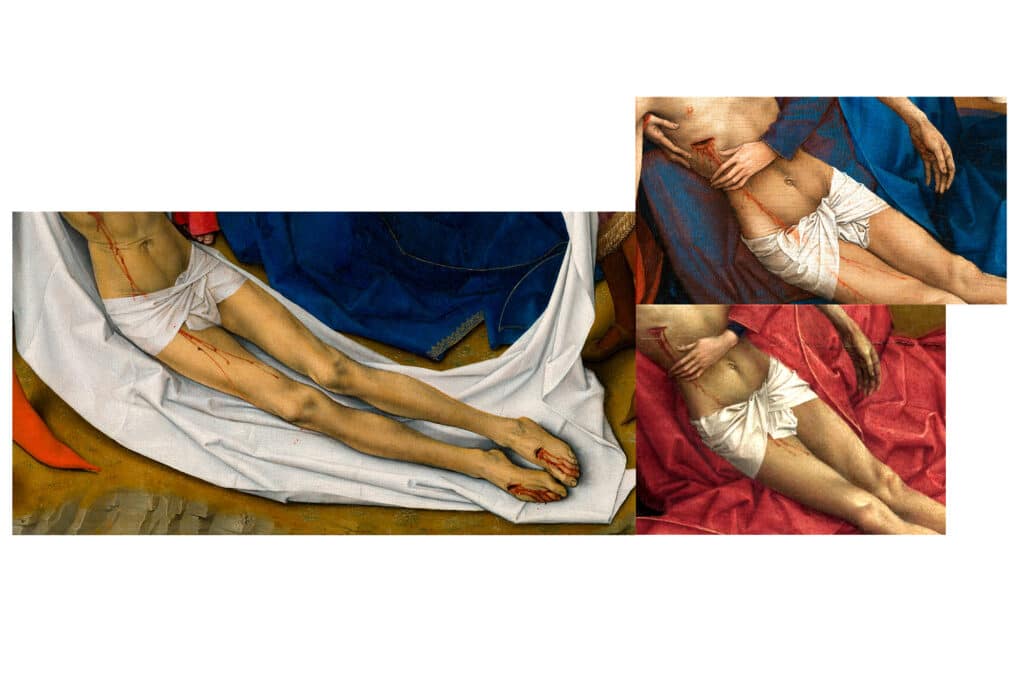
In the beginning, there was a postcard: “It had been in my studio since the 1980s. Sometimes it served as a bookmark. It was Jean-Louis Schefer [French art historian and critic who died June 8, 2022—ed.] who had sent it to me, and I was very fond of it.” A card of the Descent from the Cross by the Flemish artist Rogier van der Weyden, exhibited at the Prado Museum in Madrid. “During an exhibition on drapery at the Beaux-Arts de Lyon, this theme sparked an idea. Suddenly, I was made aware of this cloth draping Christ’s loins.” A revelation. Salmon launched into research but found no specific studies on the theme. She had her topic. The first photo she took was of a seventeenth-century sculpture of Christ she spotted at an antique shop in Troyes. “I realized at that moment that there was material for beautiful images,” she says.
Where to start? With what period? What artist to choose? A host of issues had to be addressed: there is a vast ocean of representations of Christ. Salmon first laid out a framework: “I chose to limit myself to the scenes of the Passion, between the scourging and the entombment.” She also chose to set aside popular art and Latin American representations, “which have a really different style,” as well as ex-votos and Épinal prints.
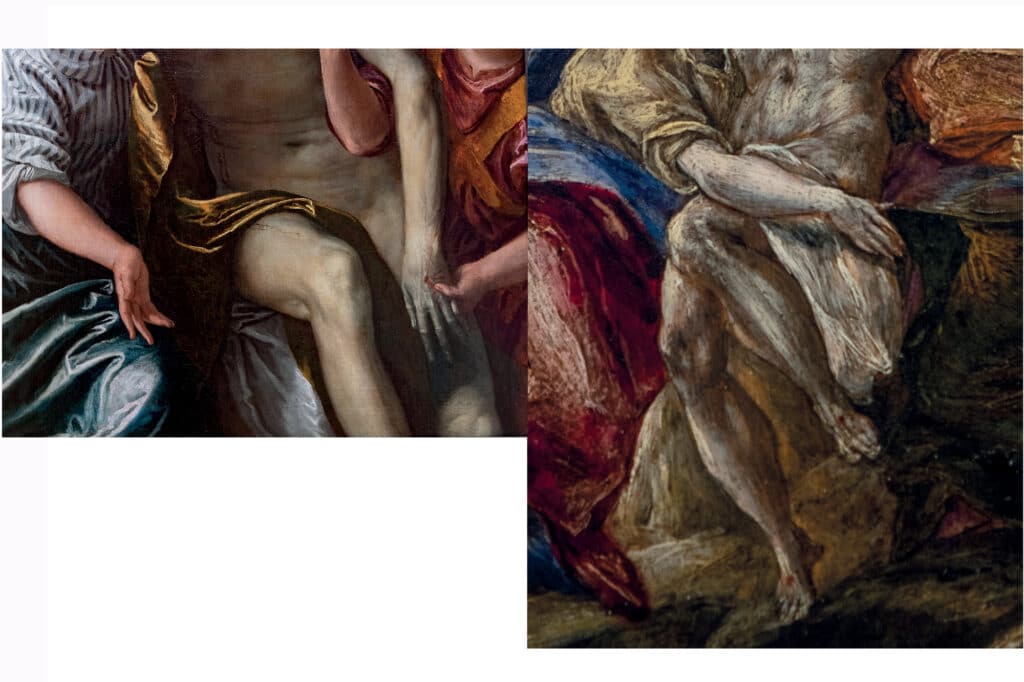
Her second constraint was temporal. The earliest representations, in particular sculptures, date to the tenth century, following the Byzantine Empire’s iconoclasm. From there, the artist time-travels through to the present, traversing the evolution of Western religious thought. Customs change, and the size and the format of the perizonium along with them. “Until the twelfth century, we observe loose drapes that fall to the knees. In contrast, in the Gothic period, we are faced with a very short loincloth, a kind of ‘sarong.’” The fourteenth century brings transparent, ever shorter drapes, to reach near-nudity after the Council of Trent and the Counter-Reformation in the late sixteenth century.
“We travel back to the origins of an image”
We are not simply confronted with image reproductions. The choice of framing, composition, and juxtapositions are part and parcel of a genuine photographic project. There are no studio or flash photos. Salomon works with the museum’s natural light. “Lighting is never adequate; sometimes rough patches of paint on the canvas catch light, reflect. But I’ve accepted to work with it.”
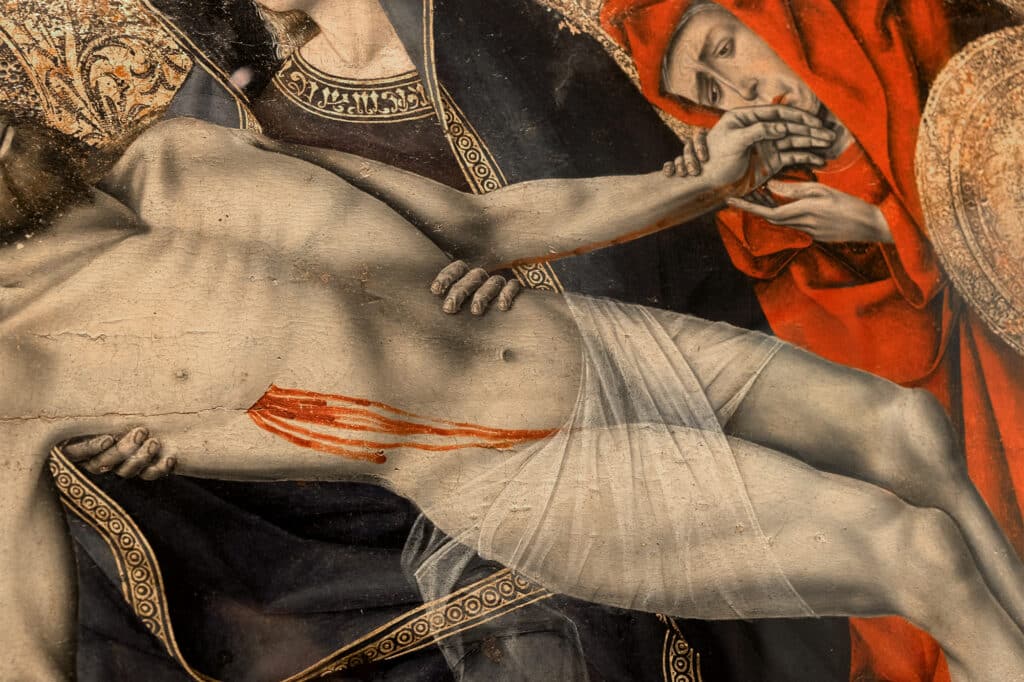
The cropping of the painting is essential to sustain the emotion of the work. “I wanted to make sure we never see faces. I wanted the human figures to be seen as little as possible and to foreground as much as possible the hands around Christ’s body.” Gently, the hands lower the body from the cross, supporting it with tenderness, while others point to parts of the body. Occasionally a face leans close to the cloth. We get an impression of profound feeling.
“Like glances, these hands function as signals. They point to key loci in a painting whose primary purpose is religious,” notes Andy Neyrotti, the curator of the exhibition, who provided the photographer with invaluable assistance with references. Sometimes Salomon enlarges the frame “so that we can recognize the painter’s touch.” She lets us glimpse large signifying landscapes or highlights small details such as the crown of thorns or the Grail. In the words of the curator, “we travel back to the origins of an image, how it is made through framing, through composition, by the colorimetry.”
“We realized that we were building an incredible museum”
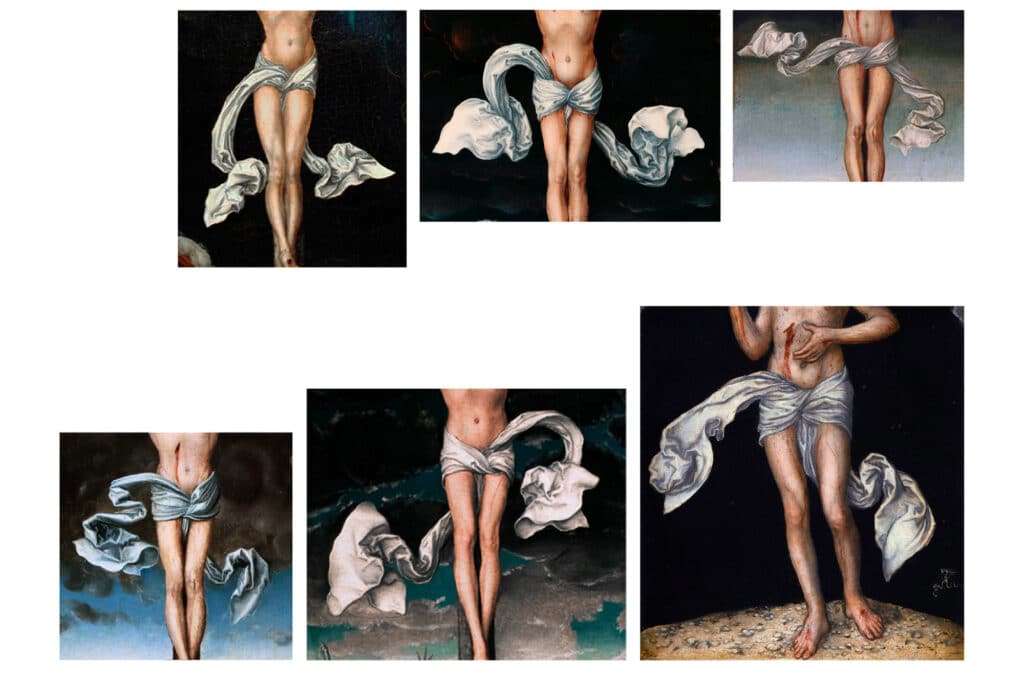
This piece of gossamer fabric, sometimes even absent, is a formidable gateway into the minds of Michelangelo, Giotto, Cimabue…. “Painters thought hard about composition,” observes Solomon. Imagery was codified by the Church and interpreted by artists according to the fashions of the time. For Neyrotti, this blind spot offers an insight into the painters’ religious philosophy. “Some reflect on who Christ is, both as human and divine, male and female. Sometimes we see women’s hips or legs appear, and a very muscular body (as in Maarten van Heemskerck).”
In Lucas Cranach, for example, the drapery is billowing in the breeze, unfolding across the full breadth of the painting, “like a real cloud, with knots that sometimes suggest erections,” notes the photographer. In the exhibition, the perizonia flutter or grow rigid, they are long or translucent, and dialogue with one another. “With Giotto, we encounter much more human scenes, blood appears, as does the transparency of the perizonia too.”
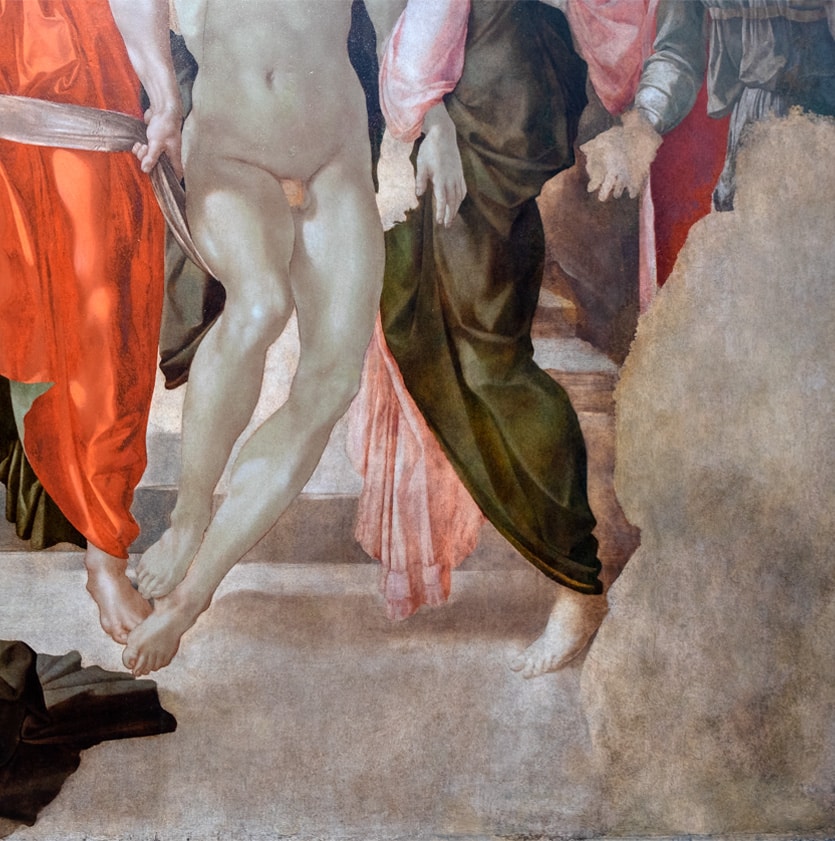
The architecture of the exhibition brings great artists into dialogue. It sets everything in motion, like a shared emotive response. “I find that our spirituality expands; there are no more anecdotes; everything gets more intense,” notes the photographer, marveling at the resulting “dance” between Michelangelo, El Greco, Caravaggio, Holbein, Lovis Corinth, or the proximity of Rembrandt’s descent from the cross and an oversize canvas by Grunewald… “We realized that we were building an incredible museum.” This did not go unnoticed by Sébastien Allard, director of the paintings department at the Musée du Louvre. “When he saw my plates, he told me that only a photographer could do that,” Jacqueline Salmon said with delight.
The interplay of perizonia
This blind spot project throws these paintings into a new light. More than that: it creates a great didactic workshop that teaches you to be attentive to the details of a given work. “When you start to think like Jacqueline and play with the perizonia, it enriches your relationship to photography,” says Neyrotti.
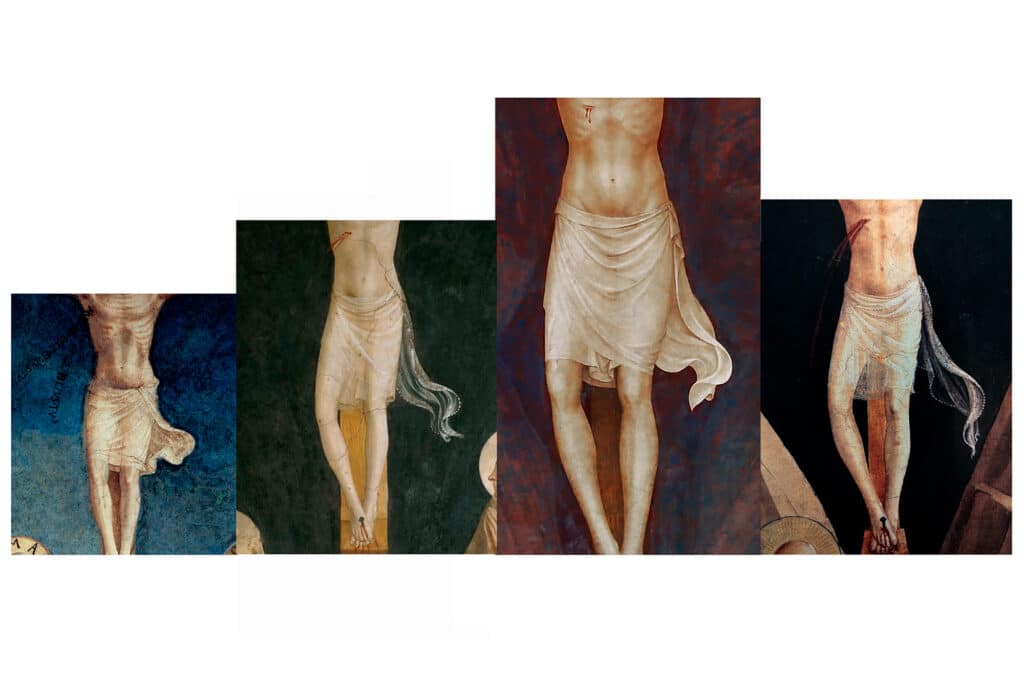
This project is also an impressive piece of documentary research that might not have been possible a couple decades ago, before the widespread digitization of works by museums. “It doesn’t just tell the story of art and drapery,” says Salomon. “It also speaks to the dispersal of the image today and the absolutely incredible access to information. Major Anglo-Saxon museums have impressive online archives of images from their collections.”
This dialogue between the painters has been a privileged and intense encounter for the artist who has devoted herself to photography since 1981: “It was a way of life for several years, I do not know what I will do now.”
Jacqueline Salomon, “The Blind Spot. Perizonia: Study and Variations”, Musée Réattu d’Arles, July 4 to September 25, 2022.

